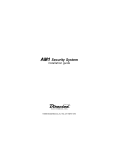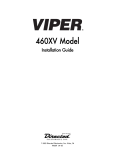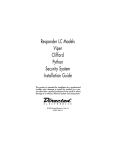Download Directed Electronics 3000 Automobile Alarm User Manual
Transcript
® 3000 Owner’s Guide limited lifetime consumer warranty For a period of one calendar year from the date of purchase of this auto-security device, Directed Electronics promises to the ORIGINAL PURCHASER to repair or replace (with a comparable reconditioned model), free of cost, any electronic control module which proves to be defective in workmanship or material under normal use, SO LONG AS THE SYSTEM WAS SOLD, INSTALLED, AND SERVICED BY A PROFESSIONAL AUTO INSTALLER, AND REMAINS IN THE CAR IN WHICH THE SYSTEM WAS ORIGINALLY INSTALLED. If warranty service is necessary you must have a clear copy of your sales receipt containing all of the information shown on the following page. After the first calendar year, from the date of purchase of this auto-security device, Directed Electronics promises to the ORIGINAL PURCHASER to repair or replace (with a comparable reconditioned model) any electronic control module which proves to be defective in workmanship or material under normal use FOR A CHARGE OF $45.00, SO LONG AS THE SYSTEM WAS SOLD, INSTALLED, AND SERVICED BY A PROFESSIONAL AUTO INSTALLER, AND REMAINS IN THE CAR IN WHICH THE SYSTEM WAS ORIGINALLY INSTALLED. If warranty service is necessary you must have a clear copy of your sales receipt containing all of the information shown on the following page. This warranty contains the entire agreement relating to warranty and supersedes all previous and contemporaneous representations or understandings, whether written or oral. IN ANY EVENT, DIRECTED ELECTRONICS IS NOT LIABLE FOR THE THEFT OF THE VEHICLE AND/OR ITS CONTENTS. This warranty is void if the product has been damaged by accident, unreasonable use, neglect, improper service or other causes not arising out of defects in materials or construction. This warranty is nontransferable and does not apply to any unit that has been modified or used in a manner contrary to its intended purpose and does not cover batteries. The unit in question must be returned to the manufacturer, postage prepaid. This warranty does not cover labor costs for the removal, diagnosis, troubleshooting or reinstallation of the unit. For service on an out-of-warranty product a flat rate fee by model is charged. Contact your authorized dealer to obtain the service charge for your unit. These systems are a deterrent against possible theft. Directed Electronics is not offering a guarantee or insuring against the theft of the automobile or its contents and disclaims any liability for the theft of the vehicle and/or its contents. Directed Electronics does not authorize any person to create for it any other obligation or liability in connection with this security system. TO THE MAXIMUM EXTENT ALLOWED BY LAW, ANY AND ALL WARRANTIES ARE EXCLUDED BY THE MANUFACTURER AND EACH ENTITY PARTICIPATING IN THE STREAM OF COMMERCE THEREWITH. THIS EXCLUSION INCLUDES BUT IS NOT LIMITED TO THE EXCLUSION OF ANY AND ALL WARRANTY OF MERCHANTABILITY AND/OR ANY AND ALL WARRANTY OF FITNESS FOR A PARTICULAR PURPOSE AND/OR ANY AND ALL WARRANTY OF NON-INFRINGEMENT OF PATENTS, IN THE UNITED STATES OF AMERICA AND/OR ABROAD. NEITHER THE MANUFACTURER OR ANY ENTITIES CONNECTED THEREWITH SHALL BE RESPONSIBLE OR LIABLE FOR ANY DAMAGES WHATSOEVER, INCLUDING BUT NOT LIMITED TO ANY CONSEQUENTIAL DAMAGES, INCIDENTAL DAMAGES, TOWING, REPAIR, REPLACEMENT, DAMAGES FOR LOSS © 2 0 0 5 d i re c t e d e l e c t ro n i c s , a l l r i g h t s re s e r v e d i OF TIME, LOSS OF EARNINGS, COMMERCIAL LOSS, LOSS OF ECONOMIC OPPORTUNITY AND THE LIKE. NOTWITHSTANDING THE ABOVE, MANUFACTURER DOES OFFER A LIMITED WARRANTY TO REPLACE OR REPAIR THE CONTROL MODULE AS DESCRIBED ABOVE. Some states do not allow limitations on how long an implied warranty will last or the exclusion or limitation of incidental or consequential damages. This warranty gives you specific legal rights, and you may also have other rights which vary from state to state. IMPORTANT NOTE: This product warranty is automatically void if its date code or serial number is defaced, missing, or altered. This warranty will not be valid unless you have completed the warranty card and mailed it to Directed Electronics within 10 days after purchase to the address listed on the warranty registration card. Make sure you have all of the following information from your dealer: A clear copy of the sales receipt, showing the following: z Date of purchase z Your full name and address z Authorised dealer's company name and address z Type of alarm installed z Year, make, model and colour of the vehicle z Vehicle registration number z Vehicle identification number z All security options installed on vehicle z Installation receipts trademarks and copyrights Bitwriter®, Clifford®, Code-Hopping®, Directed®, Doubleguard®, ESP®, FailSafe®, Ghost Switch™, Learn Routine™, Nite-Lite®, Nuisance Prevention® Circuitry, NPC®, Revenger®, Silent Mode™, Soft Chirp®, Stealth Coding™, Stinger®, Valet®, Vehicle Recovery SystemTM, VRS®, and Warn Away® are all Trademarks or Registered Trademarks of Directed Electronics. ii © 2 0 0 5 d i re c t e d e l e c t ro n i c s , a l l r i g h t s re s e r v e d table of contents limited lifetime consumer warranty . . . . . . . . . . . . . . . . . . . . .i trademarks and copyrights . . . . .ii table of contents . . . . . . . . . . . . .1 what is included . . . . . . . . . . . . . .2 important information . . . . . . . . .2 your warranty . . . . . . . . . . . . .3 remote configurations . . . . . . . . .4 standard configuration for in-key 2-button remote . . . . . .5 diagnostics . . . . . . . . . . . . . . . . . .16 arming diagnostics . . . . . . . . .16 disarming diagnostics . . . . . . .17 arm/disarm diagnostic chart . .17 table of zones . . . . . . . . . . . .18 high frequency . . . . . . . . . . . . . .19 rapid resume logic . . . . . . . . . . .19 power saver mode . . . . . . . . . . .20 system sensors and adjustments 20 programming options . . . . . . . .21 standard configuration for manual programming 3-button remote . . . . . . . . . . .5 instructions . . . . . . . . . . . . . .22 using your system . . . . . . . . . . . . .6 arming . . . . . . . . . . . . . . . . . . .6 disarming . . . . . . . . . . . . . . . . .8 disarming without a remote . . .8 auto-immobilisation . . . . . . . . .9 remote siren silencing . . . . . . .9 remote chirp muting (3-button remote only) . . . . . .10 user selectable features . . . . .24 user selectable features descriptions - column one . . .24 user selectable features descriptions - column two . . .26 user selectable features descriptions - column three . .27 pin programming . . . . . . . . . .29 remote sensor disable . . . . . .11 glossary of terms . . . . . . . . . . . . .31 remote start sensor bypass . . .11 security & convenience auxiliary channel bypass . . . . .12 expansions . . . . . . . . . . . . . . . . . .32 valet mode . . . . . . . . . . . . . . .12 quick reference guide . . . . . . . .33 remote valet mode . . . . . . . . .13 instant auto-arming bypass . .14 nuisance prevention® circuitry 14 multiple event total recall . . . .15 battery back-up siren . . . . . . . . .15 © 2 0 0 5 d i re c t e d e l e c t ro n i c s , a l l r i g h t s re s e r v e d 1 what is included z One control module/siren with built-in Tilt sensor and 24 pin main wiring harness (attached) z One Mini-Blue status LED z One 2-button Valet switch z One in-key 2-button remote z One 3-button remote z Two Merlin decal’s z This Owner’s Guide z Warranty Card important information Congratulations on the purchase of your state-of-the-art motorcycle security system. It has been designed to provide years of trouble-free operation. This system must be installed by an authorised dealer. Installation of this product by anyone other than an authorised dealer voids the warranty. As verification of authorization, all authorised dealers are provided with preprinted dealer certificates. In order to maximize the use of this system, please review this owner's guide carefully prior to using your system. You can print additional or replacement copies of this owner’s guide by accessing the Directed website at www.directed.com. note: Your system MUST be installed by an Authorised dealer in accordance with the instructions we supply them. The Merlin 3000 system is designed to be installed on any 12-volt, negative ground motorcycle or moped. 2 © 2 0 0 5 d i re c t e d e l e c t ro n i c s , a l l r i g h t s re s e r v e d note: Other than the remote controls, this system has no user-serviceable parts. Your authorized dealer can correct any system wiring problems and, if needed, can return any malfunctioning component to Directed Electronics for repair/replacement under the terms of the Limited Lifetime Warranty printed at the beginning of this guide. system maintenance The system requires no specific maintenance. The batteries in your remotes will last approximately one year under normal use. Your 3-button remote is powered by a miniature 3V lithium battery (CR2032). Your in-key 2-button remote is powered by a 12V miniature battery (type 27A). your warranty It is necessary to retain your sales receipt, which reflects that the product was installed by an authorised dealer. For full details regarding your warranty coverage, please refer to the consumer warranty section of this guide. © 2 0 0 5 d i re c t e d e l e c t ro n i c s , a l l r i g h t s re s e r v e d 3 remote configurations The 3000 system has an in-key 2-button remote control and a 3-button remote control. Two additional Merlin remote controls can be added. IN-KEY 2-BUTTON REMOTE CONTROL FRONT REAR LED ACCESSORY ARM/DISARM/PANIC 3-BUTTON REMOTE CONTROL LED ACCESSORY ARM/DISARM/PANIC SILENT ARM/DISARM 4 © 2 0 0 5 d i re c t e d e l e c t ro n i c s , a l l r i g h t s re s e r v e d remote functions This system uses computer-based code learning to learn the remote buttons. This makes it possible to assign any remote button to any system function. The remotes initially come programmed with standard configuration. The buttons in all of the instructions in this manual correspond to a standard configuration remote. standard configuration for in-key 2-button remote Button The arming, disarming, and panic functions are controlled by this button. Button An optional accessory convenience or expansion function that you have added to your system can be activated by pressing this button. and Buttons When pressed together, these buttons disable the on-board control module tilt sensor and any optionally installed sensors. standard configuration for 3-button remote Button The arming, disarming, and panic functions are controlled by this button. © 2 0 0 5 d i re c t e d e l e c t ro n i c s , a l l r i g h t s re s e r v e d 5 Button An optional accessory convenience or expansion function that you have added to your system can be activated by pressing this button. Button Silent arm and disarm is controlled by this button. and Buttons When pressed together, these buttons disable the on-board control module tilt sensor and any optionally installed sensors. and Buttons Remotely enters or exits Valet. using your system The buttons used in the instructions in this manual correspond to the standard remote configuration. If your remote has been custom configured, the icons on your remote buttons may not correspond to the indicated functions. arming You can activate, or arm, the system by pressing on your remote for one second. When the system arms, you will hear one short siren sound, or chirp, and see the parking lights flash once. The LED will illuminate steadily. 6 © 2 0 0 5 d i re c t e d e l e c t ro n i c s , a l l r i g h t s re s e r v e d While the system is armed, the LED status indicator will flash approximately once per second showing that the system is actively protecting your vehicle. If you hear more than one chirp when arming, refer to the Diagnostics section of this guide. These extra chirps confirm a malfunction autobypass. The security system also can be programmed to arm itself automatically without a remote (called passive arming). If the system is programmed for passive arming, it will automatically arm 30-seconds after the ignition is turned off. Whenever the system is in its 30-second passive-arming countdown, the siren will chirp once and the lights will flash once five seconds after countdown has commenced. This is indicated by the rapid flash from the status LED. The system is not actually armed at that point. The system arms after the 30-second countdown has elapsed, but the siren will not chirp. The early chirps provide you with a 25-second warning prior to arming. note: If one of the zone 4 or 5 switch inputs is active or the ignition is on, the system will not passively arm. Additionally, if one of these switches is activated or the ignition is turned on, the countdown will cease, then begin again when the input is removed. When armed, your vehicle is protected as follows: z The LED will flash as a visible theft deterrent. z If the tilt sensor detects the motorcycle is being moved in an attempt to steal it, the system will immediately trigger the siren and flash the indicator lights. This sensor is capable of independently learning the bike’s initial angles of vertical and horizontal inclination each time it is parked, ensuring the most accurate tilt (vertical and horizontal) sensing possible. z If a protected switch is opened, the system will immediately trigger the siren and flash the indicator lights. z The immobiliser prevents the motorcycle’s engine from starting. © 2 0 0 5 d i re c t e d e l e c t ro n i c s , a l l r i g h t s re s e r v e d 7 disarming To disarm the system, press . You will hear two chirps and the parking lights will flash twice. If the siren chirps four times when disarming, refer to the Diagnostics section of this guide. This is called Tamper Alert. If the siren is active (sounding) when the system is disarmed you will hear three chirps but the system is not disarmed. (Refer to the Remote Siren Silencing section of this guide.) However, if the alarm completes the full trigger cycle when disarmed you will hear four chirps. disarming without a remote This feature allows you to disarm the system without the remote should it be lost, damaged, or disabled. In order to disarm without a remote, you must have the motorcycle’s ignition key, know where the Valet switch is located, and have the PIN code. Be sure to check with the installer for the location of the Valet switch. Turn the ignition On and then enter the PIN code as given in the following example to disarm without a remote. 1. Find the preset PIN code given in this manual. FOR EXAMPLE: To disarm first enter a PIN code of 4301. 8 2. Turn the ignition On. 3. Press four times. 4. Then once. This enters the digit 4. 5. Then three times. 6. Then once. This enters the digit 3. 7. Then once. This enters a 0 as there was not a previous digit entered with . © 2 0 0 5 d i re c t e d e l e c t ro n i c s , a l l r i g h t s re s e r v e d 8. Then once. 9. Then once. This enters the final digit 1. auto-immobilisation Immobiliser circuits automatically activate after 30-seconds. Auto-immobilisation sequence: 1. Turn ignition off or disarm alarm. 2. After 30-seconds the systems Immobilisation circuits activate and engage the starter and engine interrupts. 3. LED flashes at ½ normal speed. Disarm the system when immobilised: Use one of the following methods to turn off auto-immobilisation. z Turn ignition on and press the mitter. z Arm the alarm and then disarm the alarm. z Turn the ignition on and enter the system Valet/PIN code. button of the trans- remote siren silencing Remote siren silencing is a feature that makes it possible to silence and reset the system when it is triggering without disarming the system. If the system is triggered and the siren is sounding, press on the remote to stop the trigger and return the unit to the armed state. The system will not disarm, but rather reset. This prevents you from disabling the system should you wish to silence it without visually checking the vehicle. After resetting the system, press again to disarm the system. © 2 0 0 5 d i re c t e d e l e c t ro n i c s , a l l r i g h t s re s e r v e d 9 When you remote siren silence, the siren will either chirp 1 or 3 times. 1-chirp indicates that the system is still armed, and that all zones are inactive and being monitored. 3-chirps indicate that the system is still armed, and that at least one zone is still active and being bypassed. NOTE: If 3-chirps sound the input that is bypassed will remain bypassed until the activation ceases. remote chirp muting (3-button remote only) To temporarily turn off the arm or disarm chirps, use remote chirp muting. Simply press on the remote (3-button remote only), and the confirmation chirp(s) will be eliminated for that one operation only. The parking lights will flash to confirm the arm/disarm command. If you want the arm/disarm chirps turned off permanently, please refer to the User-Selectable Features section of this guide. 10 © 2 0 0 5 d i re c t e d e l e c t ro n i c s , a l l r i g h t s re s e r v e d remote sensor disable This can be performed anytime the system is armed. Follow the procedure listed below. 1. Arm the system. 2. Using the remote press 3. The indicators will flash four times; all Warn Away® zones of optionally installed sensors are now bypassed (zones two and three). 4. Using the remote press again. 5. The lights will flash four more times; All optional sensor Warn away and Full trigger zones and the Tilt Sensor are now bypassed 6. The sensor zones will reset when disarmed. and simultaneously. and simultaneously note: Sensor disable can be performed at any time after the alarm has been armed. remote start sensor bypass When the system sees a command to remote start the motorcycle, it bypasses sensor zones and will continue to bypass these zones until the remote start shuts down. Note: Additional installation options required for Remote Start operation. See your Directed Authorised dealer for details. © 2 0 0 5 d i re c t e d e l e c t ro n i c s , a l l r i g h t s re s e r v e d 11 auxiliary channel bypass All alarm sensor inputs will be bypassed while a pulsed or timed auxiliary output is active. panic mode If you are threatened near your vehicle, you can attract attention by triggering the system with your remote! Just press for two sec- onds to enter Panic Mode. The siren will sound and the indicator lights will flash for the programmed duration (5-minutes maximum). To stop Panic Mode at any time press on the remote again. valet mode You can prevent your security system from automatically arming by using Valet Mode. This is very useful when washing the motorcycle for example. In Valet Mode, the security system will not arm, even with the remote, but any accessory functions will continue to work normally. To enter Valet Mode: 1. Turn the ignition On. 2. Enter the PIN code as described in the Disarming Without a Remote section. 3. When you enter the last digit continue to hold the button for at least three seconds then release. The LED status indicator will light up and 12 © 2 0 0 5 d i re c t e d e l e c t ro n i c s , a l l r i g h t s re s e r v e d remain on if Valet Mode has been entered. The LED status indicator will light steadily if you are entering Valet Mode. Note: The LED will turn off when the ignition is ON. To exit Valet Mode: 1. Turn the ignition On. 2. Enter your PIN code as described previously 3. When you enter the last digit the LED will light up, continue to hold the button. 4. The system will exit Valet mode and the status LED indicator will extinguish. NOTE: If One-time Valet is programmed On by your installer, the system will automatically exit Valet mode the next time the ignition is turned on. remote valet mode The operations described in this section refer to remote buttons. Remember, the buttons used in all the instructions in this guide correspond to the Standard Configuration for the 3-button remote. This may not be how your remote is set up. To enter Valet Mode, press and simultaneously. The LED status indicator will illuminate continuously if you are entering Valet Mode, or will turn off if you are exiting Valet Mode. © 2 0 0 5 d i re c t e d e l e c t ro n i c s , a l l r i g h t s re s e r v e d 13 instant auto-arming bypass This will bypass the auto arm feature once only. 1. With the key, turn the ignition on, then off within two seconds. 2. The siren will chirp once to confirm auto arming bypass. 3. The system will not auto arm. note: The system will revert to normal auto arming when the system sees the ignition on for at least three seconds and then turned off, or the system is armed and disarmed with the remote. During auto arming bypass the system will not auto-activate the accessory output when using the remote to arm the system. nuisance prevention® circuitry Your system has Directed’s Nuisance Prevention® Circuitry (NPC®). It prevents annoying repetitive trigger sequences due to faulty switches or environmental conditions such as thunder, jackhammers, airport noise, etc. Example: If the alarm triggers three times within a 60-minute period and each time the same sensor or switch triggers the alarm, NPC® will interpret those triggers as false alarms. After the third trigger, NPC® ignores, or bypasses, that sensor or switch (along with any other sensors or switches sharing the same zone) for 60 minutes. If the bypassed sensor tries to trigger the system while it is being bypassed, the 60-minute bypass period will start over. This ensures that a sensor that continually triggers will remain bypassed. 14 © 2 0 0 5 d i re c t e d e l e c t ro n i c s , a l l r i g h t s re s e r v e d note: Arming and disarming the system does not reset this function.The only ways to reset a bypassed zone are for it to not trigger for 60 minutes, or to turn on the ignition. If testing your system, it is important to remember that the NPC® programming can cause zones to be bypassed and appear to stop working. If five chirps are heard when disarming, NPC® has been engaged. If you wish to clear the NPC® memory, turn the ignition key on. NPC® is On/Off programmable. See your dealer and the Programming section of this guide for more information. multiple event total recall This will report the last eight system triggers in reverse chronological order. 1. Press and hold of the Valet switch. 2. While still holding , arm and disarm the system, then release the button. 3. The LED will start to flash to indicate the most recent trigger and proceed down to the eighth trigger. For more information, please refer to the Table of Zones section of this guide. battery back-up siren The built-in battery back-up siren protects the system if a thief disconnects power and/or cuts or tampers with the power supply wires while the system is armed. If system power is lost the siren will sound for five minutes and then reset. © 2 0 0 5 d i re c t e d e l e c t ro n i c s , a l l r i g h t s re s e r v e d 15 diagnostics The microprocessor at the heart of your security system is constantly monitoring all of the switches and sensors that are connected to it. It detects any faulty switches and sensors and prevents them from disabling the entire system. The microprocessor will also record and report any triggers that occurred during your absence. arming diagnostics If the system is armed while an input is active (sensor triggering, etc.) the unit will chirp once when arming and then once more five seconds later. This is called Bypass Notification. Refer to the Arm/Disarm Diagnostic Chart for bypass notification details. You are able to see exactly which zone is causing the bypass notification by disarming the system and turning the ignition on. The zone will be reported by flashing the active zone 5-times. See the Table Of Zones. The security system will ignore the input that was active when the system was armed, until the input goes away. 3-seconds later the system will monitor that input normally. For example, if the protective switch is active, you will hear one Bypass Notification chirp (the protective switch is bypassed from the alarm system). Once the protective switch is reset, then 3-seconds later the system resumes normal monitoring of this switch. 16 © 2 0 0 5 d i re c t e d e l e c t ro n i c s , a l l r i g h t s re s e r v e d disarming diagnostics Extra disarm chirps are the Tamper Alert. If four chirps are heard when disarming, the system was triggered in your absence. If four chirps are heard, the LED status indicator will indicate which zone was triggered when the ignition is turned on and will repeat 5-times (refer to the Arm/Disarm Diagnostic Chart and Table of Zones section). The system will retain this information in its memory. Refer to the Multiple Event Total Recall section of this guide. arm/disarm diagnostic chart Action No. of Chirps Description Arm 1 System armed Arm 1 (3-sec. pause) 1 System armed with zone active and bypassed Disarm 2 System disarmed Disarm 4 System disarmed with tamper alert High Security 1 Disarm (siren on) System silenced, but still armed, and all zone inputs are inactive and monitored. High Security 3 Disarm (siren on) System silenced, but still armed, and a zone is still active and bypassed. Disarm System disarmed with a zone in NPC. 5 Refer to the table of zones to identify the last zone triggered. © 2 0 0 5 d i re c t e d e l e c t ro n i c s , a l l r i g h t s re s e r v e d 17 table of zones The zone number is the number of LED flashes used by the system to identify a specific input. The standard input assignments are listed below, along with spaces to write in any optional sensors or switches you have had installed. If a Warning Zone response is triggered, the LED will not report it. Zone - Number of LED Flashes Description 1 Tilt Sensor (Built-in Tilt Sensor) 2 Auxiliary sensor 1 input 3 Auxiliary sensor 2 input 4 Normally Closed input (from protective switch) 5 Optional switch input 6 Ignition Input 7 12 V Power interruptions Dealer-Installed Options anti-code grabbing (ACG) This unit features Anti-Code Grabbing (ACG) with Random Code Encryption. This means the receiver and remotes each use a mathematical formula called an algorithm to change their code each time the remote is used. This technology has been developed to increase the security of the unit. The control unit knows what the next codes should be. 18 © 2 0 0 5 d i re c t e d e l e c t ro n i c s , a l l r i g h t s re s e r v e d high frequency Your system transmits and receives at 433 MHz. This provides a cleaner spectrum with less interference and a more stable signal. rapid resume logic This security system will store its current state to non-volatile memory. If power is lost and then reconnected the system will recall the stored state from memory. This means if the unit is in Valet Mode and the battery is disconnected for any reason, such as servicing the car, when the battery is reconnected the unit will still be in Valet Mode. This applies to all states of the system including arm, disarm, autoimmobilised and Valet Mode. © 2 0 0 5 d i re c t e d e l e c t ro n i c s , a l l r i g h t s re s e r v e d 19 power saver mode z When in Valet mode, the LED will turn off 1-hour after entering Valet mode. z After 24 hours in the armed state, the LED will decrease the flash rate to 1/2 the normal rate; after 48 hours it will decrease to 1/4 the normal rate. z After 96 hours of no activity (arm, disarm, or alarm trigger) the alarm enters sleep mode. The alarms receiver, and LED turn off to save as much battery power as possible. The system is drawing next to no current in this mode. To exit sleep mode turn the ignition on and the siren will chirp 10 times (5-seconds) before the siren sounds. Disarm the system with the remote or by entering the PIN code with the Valet switch. If any other input is activated when in sleep mode, the system will wake up and trigger the alarm immediately. system sensors and adjustments Your system was installed with an integral Tilt sensor. Optional sensors such as the 504D Double-Guard Shock sensor or 508D Dual-Zone Proximity sensor may also have been installed. For adjustments to all sensors/options, please return your motorcycle to the installing Directed® dealer. 20 © 2 0 0 5 d i re c t e d e l e c t ro n i c s , a l l r i g h t s re s e r v e d programming options Programming options control what your system does during normal operation, and require few or no additional parts. However, some may require additional installation labor. Following is a list of the program settings, with the factory settings in bold: z Autoarming on or autoarming off of the alarm : Automatic arming 30-seconds after ignition turned off. z Arming/disarming confirmation siren chirps off, loud or quiet. The siren arm/disarm chirps can be either full volume, 6 decibels quieter, or turned off completely. z Panic mode: on/off. z Siren duration: 30/60/90 seconds. z Set PIN code: Allows you to enter your own PIN code, overwriting the factory PIN code. z Siren tones: The output of the siren consists of six different tones in sequence. Any of these tones can be eliminated, resulting in a unique, easily identifiable siren sound. z NPC®: Nuisance Prevention® Circuitry on/off. Inhibits false alarming if a protective zone repetitively alarms. z Remote Valet: on/off. z Reset settings to default (except for PIN code) z New remote learn features: Allows programming individual transmitter channels to custom configurations. Refer to User Selectable Features Descriptions - Column Three. z Clear all Remotes: Removes all remote controls from memory. © 2 0 0 5 d i re c t e d e l e c t ro n i c s , a l l r i g h t s re s e r v e d 21 manual programming instructions It is a good idea to document changes by taking note of all feature changes made in programming mode. To enter the User Selectable Features programming: 1. Ignition on - Turn the ignition to the on/run position or start the engine. 2. Enter PIN - Your PIN code. FOR EXAMPLE: To enter a PIN code of 4301— Press four times, then once. This enters the digit 4. then three times, then once. This enters the digit 3 and then once. This enters a 0 as there was not a previous digit entered with . then and then 22 once, once. This enters the final digit 1. 3. Hold/Chirp/Release - After entering the PIN code, press and hold until a chirp is heard and the LED turns on, then release the button. You have now entered the feature selection position of the User Selectable Features grid. 4. Column select - Press and release the same number of times as the desired column. After a pause the siren will chirp the same number of times as the selected column for confirmation (e.g. 3-chirps means column 3 of the features is selected). 5. Feature select - Press and release the same number of times as the desired row. The siren will chirp with each press. The feature can now be changed using the remote control. © 2 0 0 5 d i re c t e d e l e c t ro n i c s , a l l r i g h t s re s e r v e d 6. Feature change - Press the button on the remote. If the system chirps once, the feature has just turned off or switched to the first setting in the grid slot for this feature; if the system chirps twice, the feature has just turned on or switched to the second setting in the grid slot. If the feature has more than two settings, continue pressing the on the remote to toggle through the settings (e.g. if the feature has 1 through 5 settings, the system will chirp 1 through 5 times for each setting selected). If you continue to press and release the remote the feature setting will wrap back around to the first setting again. (e.g. if the feature has 3 settings you will hear, 1 chirp, 2, chirps, 3 chirps, 1 chirp, 2 chirps, etc). To advance to another feature in the same column, press the same number of times as the desired feature within 60 seconds; to change a feature in a different column begin at step 5 by entering the column number first and then the feature select in step 6. note: Refer to the Feature Descriptions sections of this guide for important notes and descriptions of the system features and programming. 7. Exit programming - To exit programming mode turn the ignition off or wait 60 seconds without pressing the Valet button. The siren will chirp three times to indicate programming mode has been exited. After you change a feature setting, the feature counter is reset to zero. Hence, to change another feature in the same column you must press the button the same number of times as indicated in the chart below. © 2 0 0 5 d i re c t e d e l e c t ro n i c s , a l l r i g h t s re s e r v e d 23 user selectable features Then Press First Press Add new remote (autolearn) Set PIN code New remote learn arm/disarm only Auto arm on/off Chirps off/loud/quiet Select siren sounds New remote learn accessory output New remote learn silent mode Panic on/off Remote valet on/off New remote learn remote valet Siren Duration 30/60/90 seconds Reset to default (except transmitter and PIN code) New remote learn sensor disable Not used Not used Clear all remotes from memory NPC on/off user selectable features descriptions - column one add new remote (for 2-button in-key and 3-button remotes only) z 24 Auto-learn new remote controls to the system (one at a time) in the standard button configuration. For more information, refer to Note #1 in Programming Notes section. © 2 0 0 5 d i re c t e d e l e c t ro n i c s , a l l r i g h t s re s e r v e d auto (passive) arm - on/off z On: When the system sees the ignition turn off, it will begin a 30-second countdown before arming itself. The countdown is indicated by the system LED rapid flashing. After the first five seconds, you will hear one chirp and the indicators will flash. The system will arm 25 seconds later. z Off: The transmitter must be used to arm the system. chirps - off/loud/quiet z Off: Chirps will not sound when arming/disarming the system (with the exception of arm/disarm diagnostic chirps and programming chirps). z Loud: Chirps will sound when arming/disarming the system at full volume. z Quiet: Chirps will sound when arming/disarming the system but at a lower volume than normal (with the exception of arm/disarm diagnostic chirps and programming chirps). panic - on/off Allows the remote to activate Panic Mode. The siren will sound for 30 seconds. z On: The system will enter Panic Mode if the arm/disarm button is pressed for more than 2 seconds. z Off: Panic Mode is disabled. siren duration - 30/60/90 z The system will sound the alarm for the programmed duration (30/60/90 seconds) during an alarm trigger or when the system is put into panic mode. © 2 0 0 5 d i re c t e d e l e c t ro n i c s , a l l r i g h t s re s e r v e d 25 user selectable features descriptions - column two set pin code z This feature allows you to change your personal PIN code. For more information, please refer to the PIN Programming section of this guide. Factory default PIN number is 2. select siren sounds This feature allows you to select which siren sounds will be played back when the alarm is triggered. Use the following procedure to set this feature: 1. Enter the feature. 2. Press the button of the remote to begin the playing of siren sounds. 3. Siren will generate each sound for 5-seconds. There are 6 in total. 4. To add the sound press the while that sound is playing. 5. To delete the sound press the switch while that sound is playing. button on the Valet switch button on the Valet note: After selecting or deleting a sound the siren will immediately play the next sound. If no sounds are selected by pressing the will remain in its previous setting. or button the system NPC® on/off Nuisance Prevention® Circuitry (NPC®) stops repeated triggering of the same zone. If one zone is triggered three times in one hour, that zone is bypassed for one hour, starting from the time of the third trigger. During that hour, if the system detects a trigger on that zone again, the 26 © 2 0 0 5 d i re c t e d e l e c t ro n i c s , a l l r i g h t s re s e r v e d system resets the one hour timer. If one hour passes and the zone has not triggered again, the zone is activated and can trigger the system again. NPC® monitors sensor inputs and the door trigger. If NPC® is turned off, the system will respond to repeated triggers on the sensor inputs and will do so indefinitely. Some states have laws regulating how many times a security system can trigger before it is considered a nuisance and the vehicle is towed away. remote valet on/off This feature allows you to set remote Valet on or off. reset to default This feature allows you to restore the programming to factory defaults, except for the PIN code and remote controls programmed into the system. user selectable features descriptions - column three The features in this column pertain to programming individual remote channels in custom configurations. Following is an explanation of the features. To program specific functions to a different button, enter the function you are programming after the chirp confirmation. Press the button with which you wish to control that feature; the system will chirp to confirm that it has learned the new button. arm/disarm only z The remote control channel programmed into this feature will arm/disarm the system only. © 2 0 0 5 d i re c t e d e l e c t ro n i c s , a l l r i g h t s re s e r v e d 27 note: When programming a remote control to custom configuration, a remote button must first be learned to the arm/disarm. The rest of the features in this column can then be learned. A remote button can only be learned to one designated feature. That is, if the lock/unlock button is programmed for armed/disarmed (feature 1 in column 3), it cannot be programmed for another additional feature listed in column 3 of the User Selectable Features. accessory (-) output z The remote channel programmed into this feature will activate the accessory output. silent modeTM z The remote channel programmed into this feature will arm/disarm the system, but the siren will not chirp. remote valet on/off z The remote channel programmed into this feature will make the system enter/exit valet mode. sensor disable z The remote button programmed for this feature will make the system bypass the sensors for one arming cycle only. On the next arming cycle, zones 1, 2, and 3 will be reinstated. clear all remotes 28 z This feature will erase all remote codes from the system memory. This feature is convenient for erasing any remotes that have been lost, stolen, or incorrectly programmed into the system. z After entering this feature press the button on a remote that is programmed to the system; the siren will chirp twice to indicate that all remotes have been erased from memory. © 2 0 0 5 d i re c t e d e l e c t ro n i c s , a l l r i g h t s re s e r v e d pin programming A PIN code can have one to four digits; each digit can be from 0-9. note: A PIN code cannot begin with a zero. Programming Procedure 1. Enter the feature location (column 2, row 1) in the userselectable programming grid. 2. Immediately press and release 3. Select each digit by pressing of the Valet switch. 1-9 times, and then press to enter the number into the system. To enter a zero, press only. To program a PIN code of 1032: A. Press and release hear one chirp. once and once. You will B. Press and release once. You will not hear a chirp after programming a zero. C. Press and release three times, and then press once. You will hear three chirps. D. Press and release two times, and then press once. You will hear two chirps. 4. Wait for two siren chirps after a five second pause or five seconds after the last digit has been entered if using less than four digit code number. 5. Turn off the ignition; the siren will chirp three times. 6. The programming mode is now exited. © 2 0 0 5 d i re c t e d e l e c t ro n i c s , a l l r i g h t s re s e r v e d 29 PIN Code Confirmation Procedure Begin this procedure within 15 seconds of finishing the programming sequence or the new code will not be set. 30 1. Turn on the ignition. 2. Enter the new PIN code. 3. Press and hold for three seconds. z LED turns on: New PIN code is learned and programming is complete. z LED stays off: New PIN code is not learned and the system reverts to the old PIN code. Repeat the programming sequence. © 2 0 0 5 d i re c t e d e l e c t ro n i c s , a l l r i g h t s re s e r v e d glossary of terms Control Unit: The "brain" of your system hidden somewhere on the motorcycle where it is difficult for a thief to access. It houses the microprocessor which monitors your vehicle and controls all of the system's functions. The Merlin 3000 control unit houses the battery backup siren and Tilt sensor. Input: A physical connection to the system. An input can be provided by a sensor, switch or through an existing system on the motorcycle. LED: Blue light mounted somewhere on the motorcycle. It is used to indicate the status of your system. It is also used to report triggers and faults with the system. Tilt Sensor: A sensor integral with the control module which senses if the angle of the motorcycle has changed. Remote: Hand-held transmitter which operates the various functions of your system. Trigger or Triggered Sequence: This is what happens when the alarm "goes off" or "trips." The triggered response of your system consists of the siren sounding and indicators flashing for 30-seconds. Valet Switch: A small two-button switch mounted somewhere on the motorcycle. It is used to override the alarm when a remote is lost or damaged, or to enter or exit Valet mode and for system programming. Zone: A zone is a separate input that the alarm can recognize as unique. Each input to the system is connected to a particular zone. © 2 0 0 5 d i re c t e d e l e c t ro n i c s , a l l r i g h t s re s e r v e d 31 security & convenience expansions Here we have listed only some of the many expansion options available. Please contact your dealer for a complete list of all the options available to you. Field Disturbance Sensor: An invisible dome of coverage is established by installing the 508D "radar" sensor. Your security system can then react to any intrusions on the perimeter of the field with a warnaway response and if anyone were to intrude inside the dome the full alarm would sound. Ideal for warning people away from the motorcycle. Shock Sensor: The 504D dual-stage shock sensor can be installed to provide warn-away and alarm protection for your motorcycle if impacts are detected. Remote Start: The 561T remote start system to provide engine warm up and battery recharging. 32 © 2 0 0 5 d i re c t e d e l e c t ro n i c s , a l l r i g h t s re s e r v e d ✂ Cut along dotted line and fold for a quick and easy reference to keep in your purse or wallet. ✂ QUICK REFERENCE GUIDE function remote functions 3-button remote 2-button remote Arm/Disarm/Panic Accessory Output Silent Arm/Disarm N/A Sensor Disable Remote Valet + + + N/A ■ Transmit "Silent Arm/Disarm" to delete the arm/ disarm chirps for one operation only. ■ Transmit "Sensor Disable" once to bypass the sensor warn away chirps, twice to bypass sensors entirely. Note: The system must be armed first. ✂ system disarm To enter Valet Mode without a transmitter, turn the key to the ON position and enter your PIN code. Continue to hold on the Valet switch for five seconds. pin code entry On the Valet switch, press the number of times corresponding to the first digit of your PIN, then press once. Press to enter a zero. Repeat this for each digit of your PIN code. There is a space provided below to note your pin code for future reference. ✂ valet mode entry Cut along dotted line and fold for a quick and easy reference to keep in your purse or wallet. To disarm the system without a transmitter, turn the key to the ON position and enter your PIN code. The company behind this system is Directed Electronics. Since its inception, Directed Electronics has had one purpose, to provide consumers with the finest vehicle security and car stereo products and accessories available. The recipient of nearly 100 patents and Innovations Awards in the field of advanced electronic technology, Directed is ISO 9001 registered. Quality Directed Electronics products are sold and serviced throughout North America and around the world. Call (800) 274-0200 for more information about our products and services. Directed Electronics is committed to delivering world class quality products and services that excite and delight our customers. Vista, CA 92081 www.directed.com © 2005 Directed Electronics - All rights reserved G225T 10-05







































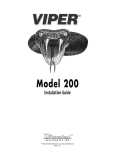







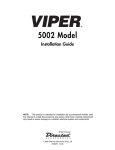

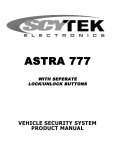
![[ OWNER`S GUIDE ]](http://vs1.manualzilla.com/store/data/007393674_1-d669bbef5ef15d65ade3b96b33459313-150x150.png)
